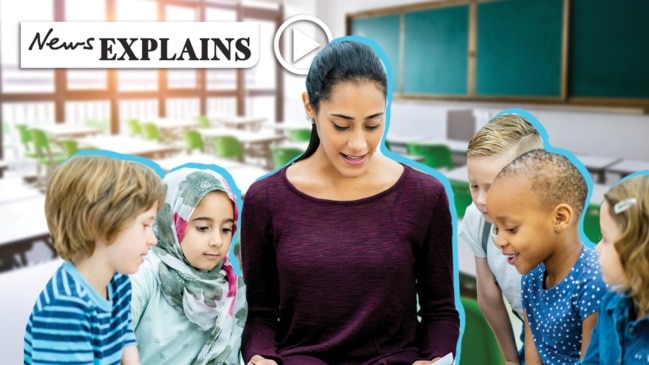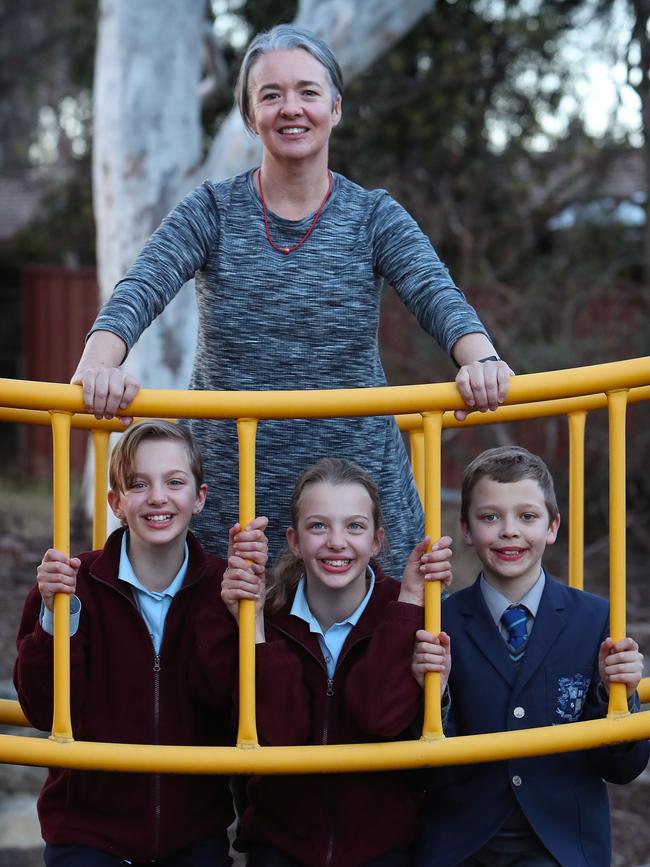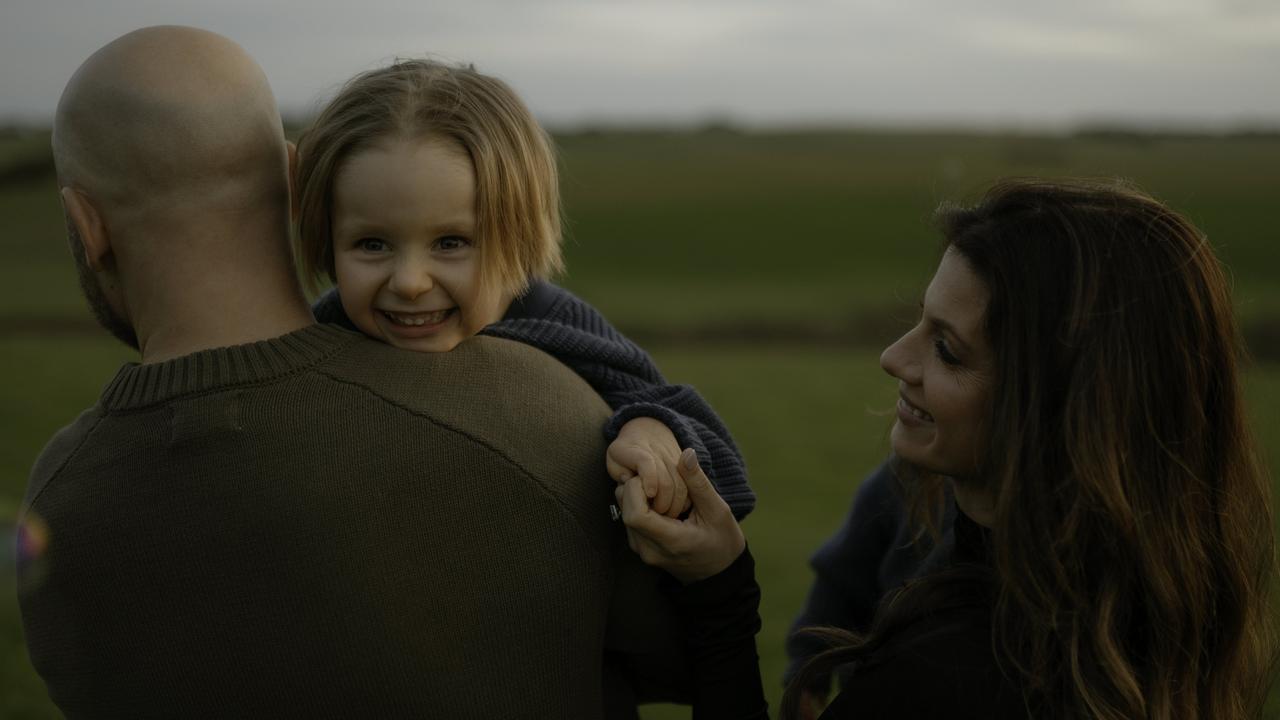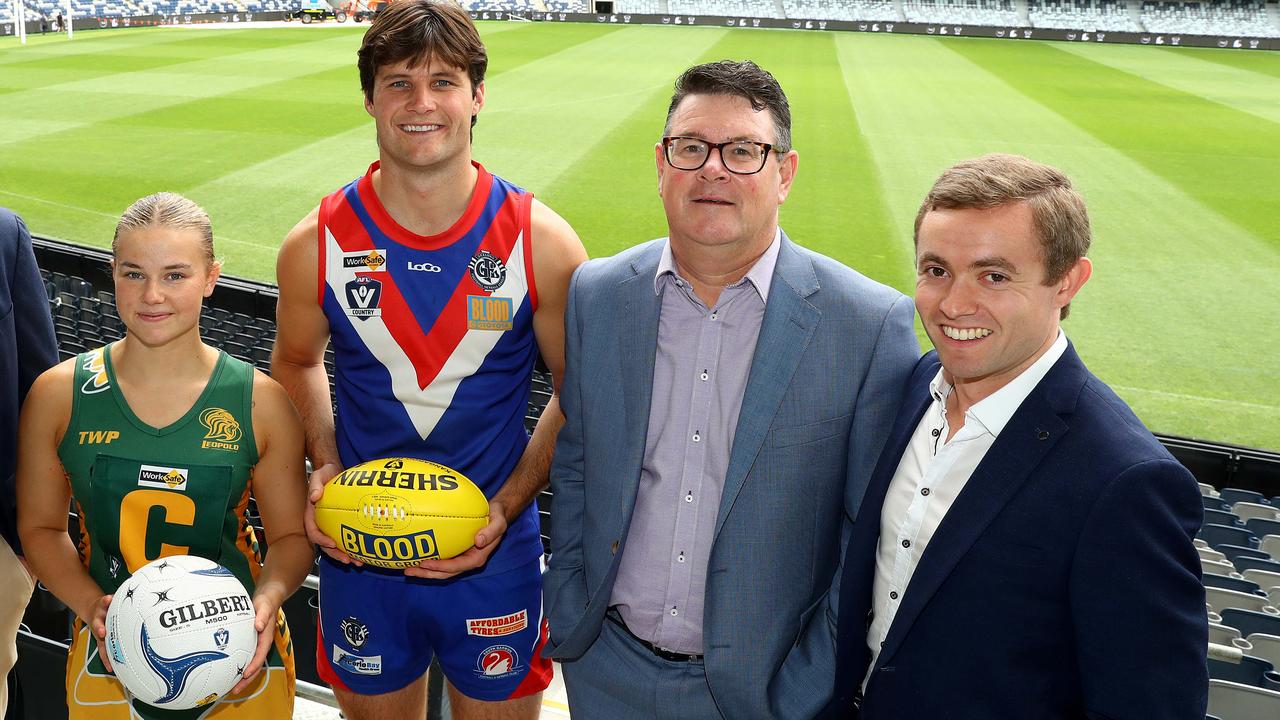Teachers v students: Our 20 most improved schools
As new data on student-teacher ratios fuels the debate about school resourcing, one expert has detailed exactly how much our kids’ learning could improve in smaller classes — but teachers will need to change their ways too.

News
Don't miss out on the headlines from News. Followed categories will be added to My News.
Some Australian schools have improved their student-teacher ratio by up to 74 per cent in the five years to 2018, new data has found.

The data from 9581 primary and secondary schools across the country, analysed by News Corp, has shown 20 schools have improved their ratios by up to 50 per cent since 2013.
Queensland’s Australian Christian College-Moreton has increased their ratio by 50 per cent since 2013, when they had 1425 students and 33.5 teachers.
In 2018, they had just 1179.2 students, yet 55.6 teachers.
Other analysis shows:
• Rockingham Montessori School in WA had an increase of 55.96 over the same period, going from 10.3 teachers for 146 pupils in 2013, to 27.4 teachers and 170.9 pupils in 2018 — bringing their ratio from 14.17 to just 6.23.
• In NSW, Central Learning Intensive English High School had a 53 per cent improvement, having 37.9 teachers for 225 pupils in 2013 — and 44.3 teachers for just 123 pupils in 2018.
The figures come after it was revealed that almost a third of Australian primary and secondary schools do not meet the OECD average student-teacher ratio of 15 pupils to one teacher.
• FROM MONDAY 16 SEPTEMBER: Full data on student-teacher ratios at the schools near you
A spokesman for the NSW Department of Education said the allocation of teaching staff in NSW public schools was determined by formulae based on student enrolments.
“Schools may also engage additional staff using flexible needs-based funding,” he said.
It should be noted, teacher ratios take into account non-teaching staff such as principals and do not directly translate into class sizes.
And while not all experts agree that small class sizes make a significant difference in learning, they do believe that changing teacher — and therefore student — behaviour, was critical to improvements in the classroom.

Matt Deeble, Director of Education at Social Ventures Australia and Evidence for Learning, said smaller class sizes were shown to have a small positive impact on learning, particularly in a child’s first years at school — although at a high cost.
“Reducing class size appears to result in around three months’ additional progress for students, on average,” Mr Deeble said.
He said the key issue was whether the reduction was large enough to permit a teacher to change their teaching approach when working with a smaller class and whether, as a result, the students change their learning behaviours.
John Hattie, Laureate Professor at the Melbourne Graduate School of Education, conducted a study on class sizes in 2010, and found that for smaller class sizes to make a difference to pupils, they had to be less than 15.
And along with class sizes, teachers had to adapt to the change and teach differently for the change to count.
“Imagine if we retrained teachers to optimise the power of smaller classes. No one has really done that.”
He said schools often advertised small classes to attract parents, but at the end of the day, teaching played the biggest part in student engagement and development.

Southern Cross University Adjunct Associate Professor David Zyngier, who was asked to review 112 different class size studies from across the world to provide recommendations to government, said that in the first years of primary school, small class sizes were critical.
“I would be staying away from any class that has 30 kids in it, anywhere, unless it was a Year 12 class,” Dr Zyngier said.
“We as human beings are evolved to walk and talk all by ourselves, but reading is an artificial task — and to make sense of those squiggles and decode them is a huge leap for little human beings.
“And that is much easier to do in a smaller class than it is to do in a larger class.”
He called for an ‘all hands on deck’ approach in which all classroom teachers at lower primary levels come in to help when a class is doing literacy or numeracy — whether that is the physical education teacher, the art teacher or the music teacher.
“They are all capable of assisting — so they can reduce the class size,” he said.
“It is quite clear for disadvantaged children that the first three of four years of education have a lasting impact, which carries right through to Year 12 — and students who have had that experience do better in their final years of education.”

ACT mother Ali Mountfield separated her triplets Lucy, Oscar and Hannah Smit, after Year 3, sending Oscar to a different boys’ school.
“Being triplets it has helped him to develop his individuality, and if required I’d send the girls to different school — we’re off to high school next year,” she said.
“Class size does matter and we have never been in a size that seemed to have an impact on the kids.
“The girls have close to 23 in their class so they are not excessive sizes, and they are in a composite class which has been good for them to have the influence of an older group.”
Australia’s 20 schools with most improved student-teacher ratios
1. Nyirripi School
Nyirripi, NT
2013: Enrolment 46; FTE (full-time equivalent) teacher 1
2018: Enrolment 35; FTE teachers 3
Student-teacher ratio: 2013 46; 2018 11.66
2. Northern Territory School of Distance Education
The Gardens, Darwin, NT
2013: Enrolment 112.4; FTE teachers 46.5
2018: Enrolment 22.5; FTE teachers 29.7
Student-teacher ratio: 2013 2.41; 2018 0.75
3. La Perouse Public School
La Perouse, Sydney, NSW
2013: Enrolment 50; FTE teachers 3.8
2018: Enrolment 34; FTE teachers 7.2
Student-teacher ratio: 2013 13.15; 2018 4.72
4. The Gums State School
The Gums, QLD
2013: Enrolment 26; FTE teacher 1
2018: Enrolment 30; FTE teachers 3.2
Student-teacher ratio: 2013 26; 2018 9.37
5. Tuart College
Tuart Hill, Perth, WA
2013: Enrolment 474.4; FTE teachers 35.3
2018: Enrolment 73.3; FTE teachers 14.2
Student-teacher ratio: 2013 13.43; 2018 5.16
6. Learning Co-Operative School
Hurstbridge, VIC
2013: Enrolment 26; FTE teachers 1.2
2018: Enrolment 22; FTE teachers 2.5
Student-teacher ratio: 2013 21.66; 2018 8.8
7. Alpha State School
Alpha, QLD
2013: Enrolment 69.7; FTE teachers 7.7
2018: Enrolment 36.8; FTE teachers 9.6
Student-teacher ratio: 2013 9.05; 2018 3.83
8. Carraragarmungee Primary School
Londrigan, VIC
2013: Enrolment 61; FTE teachers 4.8
2018: Enrolment 24; FTE teachers 4.4
Student-teacher ratio: 2013 12.7; 2018 5.45
9. Rockingham Montessori School
Rockingham, WA
2013: Enrolment 146; FTE teachers 10.3
2018: Enrolment 170.9; FTE teachers 27.4
Student-teacher ratio: 2013 14.17; 2018 6.23
10. Congupna Primary School
Congupna, VIC
2013: Enrolment 59; FTE teachers 3.6
2018: Enrolment 53.4; FTE teachers 7.4
Student-teacher ratio: 2013 16.38; 2018 7.21
11. Dirranbandi P-10 State School
Dirranbandi, QLD
2013: Enrolment 130; FTE teachers 12.4
2018: Enrolment 52.2; FTE teachers 11.2
Student-teacher ratio: 2013 10.48; 2018 4.66
12. Stansbury Primary School
Stansbury, SA
2013: Enrolment 28; FTE teachers 2.4
2018: Enrolment 23; FTE teachers 4.4
Student-teacher ratio: 2013 11.66; 2018 5.22
13. Keyneton Primary School
Keyneton, SA
2013: Enrolment 35; FTE teachers 2.5
2018: Enrolment 27; FTE teachers 4.3
Student-teacher ratio: 2013 14; 2018 6.27
14. Forestville Montessori School
Forestville, Sydney, NSW
2013: Enrolment 166; FTE teachers 16.8
2018: Enrolment 85; FTE teachers 18.7
Student-teacher ratio: 2013 9.88; 2018 4.54
15. Central Sydney Intensive English High School
Alexandria, Sydney, NSW
2013: Enrolment 225; FTE teachers 37.9
2018: Enrolment 123; FTE teachers 44.3
Student-teacher ratio: 2013 5.93; 2018 2.77
16. Minimbah Primary School
Armidale, NSW
2013: Enrolment 65; FTE teachers 4
2018: Enrolment 49; FTE teachers 6.4
Student-teacher ratio: 2013 16.25; 2018 7.65
17. Wilsons Creek Public School
Mullumbimby, NSW
2013: Enrolment 64; FTE teachers 3.7
2018: Enrolment 32; FTE teachers 3.8
Student-teacher ratio: 2013 17.29; 2018 8.42
18. Bellbrook Public School
Bellbrook, NSW
2013: Enrolment 43; FTE teachers 2.6
2018: Enrolment 22; FTE teachers 2.7
Student-teacher ratio: 2013 16.53; 2018 8.14
19. Curtin Primary School
Manning, Perth, WA
2013: Enrolment 167.1; FTE teachers 13
2018: Enrolment 101.4; FTE teachers 15.9
Student-teacher ratio: 2013 12.85; 2018 6.37
20. Australian Christian College — Moreton
Caboolture, QLD
2013: Enrolment 1425; FTE teachers 33.5
2018: Enrolment 1179.2; FTE teachers 55.6
Student-teacher ratio: 2013 42.53; 2018 21.2
Originally published as Teachers v students: Our 20 most improved schools


